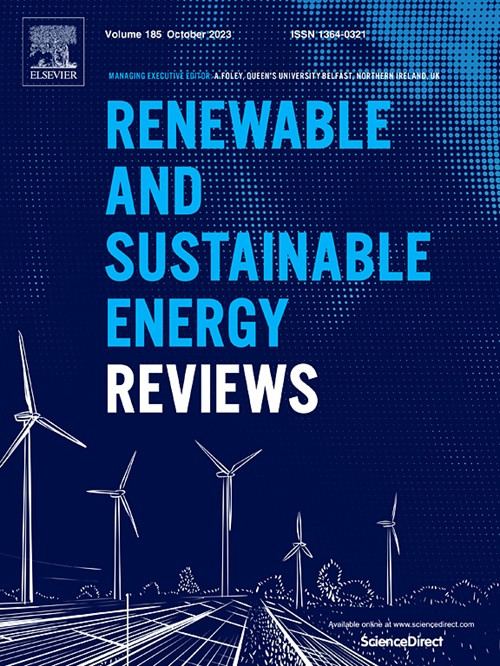Layered double hydroxides-based nanomaterials for biodiesel production
IF 16.3
1区 工程技术
Q1 ENERGY & FUELS
引用次数: 0
Abstract
Biodiesel synthesis via catalytic transesterification has emerged as a promising sustainable energy production process. Developing green and efficient catalysts is crucial to enable industrially biodiesel production. Recently, advanced layered double hydroxides (LDHs)-based nanomaterials have received extensive attention owing to their thermal stability, composition and alkalinity adjustability, enabled by the presence of various metal cations and interlayer anions. However, the targeted design of LDHs-based nanomaterials, including tuning the structural composition of LDHs to systematically understand the structure-activity relationships between LDHs structures and their catalytic transesterification activity, remains challenging. Additionally, the integration of LDHs-based catalysts with advanced reaction systems to improve biodiesel yield has yet to be explored. This review systematically explores the prospects of LDHs-based catalysts in biodiesel production and gives emphasis on the reaction mechanism, catalyst design principles, and reaction systems optimization. This review begins with an overview of the catalytic transesterification mechanism, detailing the preparation methods for LDHs and their derivatives, especially the advanced design strategies. The applications of LDHs-based catalysts in biodiesel production are summarized, highlighting the structure-activity relationship that govern biodiesel yield. Furthermore, we focus on the recent developments of advanced reaction systems used to improve conversion efficiency. Finally, the challenges and prospects concerning the application of LDHs-based nanomaterials for biodiesel production are also discussed. This review will provide critical guidance for designing high-efficiency LDHs-based catalysts and integrating them with advanced reaction systems, thereby advancing innovations in biodiesel production.

用于生物柴油生产的层状双羟基纳米材料
催化酯交换法合成生物柴油已成为一种有前途的可持续能源生产工艺。开发绿色高效的催化剂是实现生物柴油工业化生产的关键。近年来,先进的层状双氢氧化物(LDHs)基纳米材料由于其热稳定性、组成和碱度可调节性而受到广泛关注,这种材料是通过各种金属阳离子和层间阴离子的存在而实现的。然而,定向设计LDHs纳米材料,包括调整LDHs的结构组成,以系统地了解LDHs结构与其催化酯交换活性之间的结构-活性关系,仍然具有挑战性。此外,将ldhs催化剂与先进的反应体系相结合以提高生物柴油的产率还有待探索。本文系统探讨了ldhs催化剂在生物柴油生产中的应用前景,重点介绍了反应机理、催化剂设计原则和反应体系优化。本文首先综述了催化酯交换反应机理,详细介绍了LDHs及其衍生物的制备方法,特别是其先进的设计策略。综述了ldhs催化剂在生物柴油生产中的应用,重点介绍了影响生物柴油产率的构效关系。此外,我们重点介绍了用于提高转化效率的先进反应系统的最新发展。最后,讨论了ldhs纳米材料在生物柴油生产中的应用面临的挑战和前景。这一综述将为设计高效的ldhs催化剂并将其与先进的反应系统相结合提供重要的指导,从而推动生物柴油生产的创新。
本文章由计算机程序翻译,如有差异,请以英文原文为准。
求助全文
约1分钟内获得全文
求助全文
来源期刊

Renewable and Sustainable Energy Reviews
工程技术-能源与燃料
CiteScore
31.20
自引率
5.70%
发文量
1055
审稿时长
62 days
期刊介绍:
The mission of Renewable and Sustainable Energy Reviews is to disseminate the most compelling and pertinent critical insights in renewable and sustainable energy, fostering collaboration among the research community, private sector, and policy and decision makers. The journal aims to exchange challenges, solutions, innovative concepts, and technologies, contributing to sustainable development, the transition to a low-carbon future, and the attainment of emissions targets outlined by the United Nations Framework Convention on Climate Change.
Renewable and Sustainable Energy Reviews publishes a diverse range of content, including review papers, original research, case studies, and analyses of new technologies, all featuring a substantial review component such as critique, comparison, or analysis. Introducing a distinctive paper type, Expert Insights, the journal presents commissioned mini-reviews authored by field leaders, addressing topics of significant interest. Case studies undergo consideration only if they showcase the work's applicability to other regions or contribute valuable insights to the broader field of renewable and sustainable energy. Notably, a bibliographic or literature review lacking critical analysis is deemed unsuitable for publication.
 求助内容:
求助内容: 应助结果提醒方式:
应助结果提醒方式:


